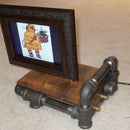Introduction: Bottle Opener From Supercomputer Enclosure Key
Welcome to my fastest instructable ever.
In the full spirit of the current speed challenge that is asking to modify something, I made this project and created this instructable in about 36 hours total time from beginning to end. That's definitely a record for me, but I started 2 days before the contest deadline ended. (And yes, I slept and ate and cleaned up as well.)
For a while now I wanted to use a bunch of enclosure keys that got tossed at work to make bottle openers. These enclosure keys were actually coming from a supercomputer build. This challenge was just the right nudge to get going. These keys work perfectly as bottle openers and by upgrading them with some nice wood handles made from wood branches that I rescued from my fire wood pile I felt like the upcycling king himself.
These could make some good presents and I know that I'll be checking for more keys in the near future. I am looking forward to your comments and hope you'll enjoy the build.
Superbender
Step 1: Materials
In this step I'll be listing all the materials that were used in this build.
- Wooden Branches. 1.5"-2" in diameter
- Thicker pieces work, but you need to turn them down more
- Crooked pieces make the patterns more interesting
- Straight pieces make the turning a little easier
- Thicker pieces work, but you need to turn them down more
- Enclosure Key. Size #5
- Yes, you can actually buy these.
- Ensure that the lip does not have a chamfer. It will work better as a bottle opener without one.
- I scored about 10 of these dumpster diving. Lucky me.
- Alternatively you could use a paint can opener as shown in the pictures. Not as pretty, but much cheaper and they work just as fine.
- Two Component Epoxy
- The one I used hardens in 5 min.
- Finishing oil (danish oil) & rag
- String
- Unused beer bottles for testing
- Note that one test is not sufficient. Making sure the results are reliable is key.
Step 2: Tools
In this step I'll be listing all the tools that were used in this build.
- Personnel protective equipment
- Safety glasses
- Hearing protection
- Dust mask
- Sanding equipment
- Disk sander
- Orbital sander with 80 grit & higher
- Sand paper 150, 220, & 400 grit
- Sanding sponges 150 & 220 grit
- Measurement tools
- Ruler or similar
- Calipers
- Pencil
- Lathe & turning tools
- Drill press & drill bits
- Center punch & hammer
- Scroll saw or hand saw
- Mallet
Step 3: Preparing the Enclosure Key
I thought that a press fit in addition to some glue would probably be the easiest and strongest way to join the enclosure key with the handle. In this step we are preparing the enclosure key. Make sure you are wearing your protective equipment.
- Remove the "flags" of the key so that the tip of the key becomes a tube. I used a sanding disk to accomplish this, carefully sanding the flag away. Alternatively you can use a saw, a file, or a Dremel tool.
- The tip of the key was not solid, but more like a tube. Drill a hole through that section. This hole will give the glue a section to flow into and connect with the wall. I hoped that this would support the joint between handle and key.
- Determine about the middle of this section.
- With a center punch mark the drill location.
- With a drill press drill a hole through both walls of the tube.
Step 4: Preparing the Handle
In this step we are preparing the wood for the turning process.
- Pick or cut pieces of wood that are between 1.5" - 2" in diameter. If you can grab them with your hand like shown in the picture then you have the minimum work on the lathe.
- You need at least one of the cut surfaces to be orthogonal to the stick. This will allow for straight mounting on the lathe. If needed cut the surfaces accordingly with a chop saw, scroll saw, or hand saw.
- I found that wood pieces with dark and light colors and offshoots give the nicest patterns for the handles.
- Roughly measure the diameter of the wood piece and divide it by two.
- Then mark that value from four sides on the wood.
- With the center punch make a divot in between the four lines. This is the mounting location for this side.
- Repeat on the other side.
Step 5: Turning the Handle
In this step I describe how I turned the handles. Please note that I am far from an expert on the lathe. Actually, I am a quite the beginner. So please take these steps here with a grain of salt. They got the job done, but I'd appreciate any comments on how I can improve this procedure.
I am describing this process by using the parts of the lathe as described in this link.
Wear your eye, ear, and breathing protection when you work.
- If your wood piece is far from round you can use a scroll saw or hand saw to trim the most protruding pieces. This will save you time and makes the process easier and safer.
- Mount the wood piece on the lathe
- Align the drive spindle with the divot from the center punch on one side of the wood piece.
- Move the tailstock towards the headstock until the live center makes contact to the wood piece as well.
- Ensure that the live center is aligned with the second divot of the wood piece.
- Lock the tailstock to the lathe body.
- Use the tailstock handwheel to advance the live center towards the wood piece and thus fasten the wood piece safely between headstock and tailstock.
- Lock the tailstock wheel.
- Attach the tool rest to the lathe to a height a little bit above the center of the wood piece.
- Ensure the lathe is unplugged.
- Turn the wood piece with your hand to check that the wood piece can spin freely and does not touch the tool rest.
- Turn the wood down with a roughing gouge.
- Start slowly and work on the protruding knots and other irregularities first.
- I started typically with removing the entire bark.
- Once you have the bark removed, and have a roundish shape, start to try different designs.
- I explored the shapes created by using a round nose scraper, skew chisel or a smaller roughing gouge.
- I created conical shapes, long round lines, and wavy lines.
- There is no limit in making dust. Go to town.
- Make sure that your transitions between features are soft and continuous.
- When you are happy with your general shape work with the sand paper
- Remove the tool rest.
- Rip of a small piece of 150 grit and turn on the lathe.
- Press the sand paper with your hand against the wood and work back and forth.
- Switch fingers frequently and don't press too hard. The sand paper will get hot.
- Repeat with 220 and 400 grit sand paper.
- Once everything was smooth start to work on reducing the diameter of the ends.
- Attach the tool rest again.
- Shape the ends by making them as thin as you dare.
- I am still developing this skill, but felt more confident with each piece I made.
- Repeat the sanding step and make sure the transition to the previously sanded pieces is smooth.
Step 6: Finishing the Handle
In this step we'll be finishing the handle.
- Remove the wood piece
- Unlock the tail stock.
- Retract the live center with the tailstock handwheel while holding the wood piece.
- Cut the ends of the wood piece at the proper location with a scroll saw (or other saw).
- Sand, sand, sand.
- I started with an 80 grit orbital sander. That saved me a lot of time.
- I continued with 120 grit sponge and also used sandpaper on top of the sponge surface. The sponge allowed to more easily create round ends as I found out after a while.
- Increase the grit size in steps up to 400 grit.
- With the drill press and a small drill (1/8" or smaller) drill a pilot hole into the end where the bottle opener goes.
- Measure the diameter of the enclosure key shaft.
- Select a drill that is a a little bit smaller than the shaft.
- In my case the shaft was 8.8 mm and the drill was 8.6 mm in diameter
- Determine how deep the shaft should go into the handle.
- In my case the shaft was 60 mm long and I made the hole in the handle 50 mm deep.
- Carefully align your wood piece and drill into the top. I am intentionally not showing what I have done here as I don't think it was good practice and rather unsafe. I got the work done, but am looking forward to get a chuck for my lathe that will make this much easier.
Step 7: Finishing the Bottle Opener
In this section we are joining the wooden handle and the enclosure key to finish the bottle opener.
- Mix a small portion of 2 component epoxy.
- Feed the epoxy carefully into the hole of the handle, making sure not to let it touch the rim of the hole.
- You only need enough epoxy to fill the bottom section of the hole to make a good contact between the wood, the key, and the holes you have drilled into the tip of the key. Too much and it may come out the top, which is something you really want to prevent.
- Press the tip of the enclosure key into the hole with your hand as far as you can go.
- With a mallet, hammer the key into the handle until it hits the bottom of the hole. The sound should change quite noticeably when that happens.
- Let the epoxy dry.
- Hang up the bottle opener with a string.
- Find an old rag and highlight the features of the wood by rubbing a danish oil onto the surface.
- Wait for an hour to let the handle dry.
Congratulations. Put a twelve pack in the fridge for testing.
Step 8: Glamour & Additional Shots
Thanks for hanging in there to the end. Here are some glamour shots. This was my first real lathe project and I am rather thrilled how it turned out. The bottle openers will make excellent presents and they work. I tested all of them. It was quite amazing how some of the most mediocre looking wood pieces had these amazing gorgeous patterns in them. The first two pictures show the same piece of wood. I found this project both fascinating and motivating and I am sure I'll return to the lathe soon to make some more dust.
Until next time.
Superbender

Participated in the
Modify It Speed Challenge













